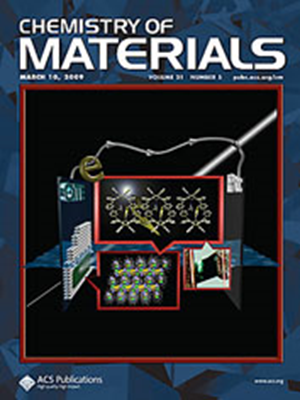Topological Photoluminescence and Slow Magnetic Relaxation in a Quasi One-Dimensional Stoichiometric Ternary Tb(III) Cyanamide
IF 7.2
2区 材料科学
Q2 CHEMISTRY, PHYSICAL
引用次数: 0
Abstract
Technological advances are intangibly linked to the preparation and description of new solid-state materials. Recently, low-dimensional lanthanide-based systems have received particular attention for their interesting magnetic and luminescent properties. Thus, motivated by the emergence of such “NCN” chemistry, we present the synthesis of the stoichiometric Tb(III) cyanamide LixNa1–xTb(NCN)2, which crystallizes in an orthorhombic structure where the magnetic Tb3+ ions are arranged in well-separated one-dimensional chains parallel to the c axis. Luminescence studies show phosphor-like behavior with a process of energy migration probed to be one-dimensional due to the large difference in the size of the intra- and interchain transfer probabilities. As a consequence, a long luminescent lifetime of 1.22 ms was observed at 100 K. In contrast, AC magnetic susceptibility studies reveal a slow magnetic relaxation process, with a relaxation time of 4.03 μs, thus establishing a good correlation between the compound’s 1D structure and its luminescent and magnetic properties. This work represents a fine example of a Tb(III)-based solid-state cyanamide compound exhibiting slow magnetic relaxation and slow radiative decay.

求助全文
约1分钟内获得全文
求助全文
来源期刊

Chemistry of Materials
工程技术-材料科学:综合
CiteScore
14.10
自引率
5.80%
发文量
929
审稿时长
1.5 months
期刊介绍:
The journal Chemistry of Materials focuses on publishing original research at the intersection of materials science and chemistry. The studies published in the journal involve chemistry as a prominent component and explore topics such as the design, synthesis, characterization, processing, understanding, and application of functional or potentially functional materials. The journal covers various areas of interest, including inorganic and organic solid-state chemistry, nanomaterials, biomaterials, thin films and polymers, and composite/hybrid materials. The journal particularly seeks papers that highlight the creation or development of innovative materials with novel optical, electrical, magnetic, catalytic, or mechanical properties. It is essential that manuscripts on these topics have a primary focus on the chemistry of materials and represent a significant advancement compared to prior research. Before external reviews are sought, submitted manuscripts undergo a review process by a minimum of two editors to ensure their appropriateness for the journal and the presence of sufficient evidence of a significant advance that will be of broad interest to the materials chemistry community.
 求助内容:
求助内容: 应助结果提醒方式:
应助结果提醒方式:


